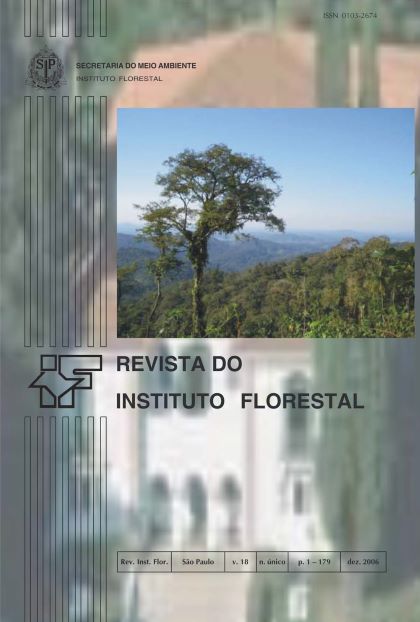O EFEITO DA FRAGMENTAÇÃO FLORESTAL NA COMPOSIÇÃO E RIQUEZA DE ÁRVORES NA REGIÃO DA RESERVA MORRO GRANDE (PLANALTO DE IBIÚNA, SP)
DOI:
https://doi.org/10.24278/2178-5031.200618329Keywords:
arboreal community, Atlantic Forest, biodiversity, floristic composition, forest fragmentation, habitat lossAbstract
Several structural and functional modifications have been indicated as result of the process of fragmentation of the forest communities. To evaluate some of these effects, we compared the species composition and richness of sites situated in two landscapes at the Ibiúna Plateau (Cotia and Ibiúna municipalities, SP). Both landscapes are situated in similar abiotic conditions, but one is predominantly forested (the Morro Grande Forest Reserve – 9,400 ha, where six areas were sampled) and the other is an agricultural landscape (where were sampled 21 fragments, ranging from 0.9 to 275 ha). We used the point-centered-quarter method considering trees with diameter equal or wider than 5 cm at breast height and included a total of 2,400 individuals in the Reserve and 5,000 individuals in the fragmented landscape. We observed 362 species from 171 genus and 71 families. The richest families were Myrtaceae, Lauraceae, Fabaceae, Rubiaceae and Euphorbiaceae. In the set of the fragments has observed differences in the species composition and smallest richness. In the fragments occurred more abundance and richness of anemochorous and barochorous and of pioneer and initial secondary species. Inversely, in the Morro Grande Reserve occurred more abundance and richness of final secondary and umbrophilous and of zoochorous species, detaching the importance of this area for the maintenance of regional biodiversity. Despite these clear fragmentation effects some threatened species or some species that were never observed in the state of São Paulo were sampled exclusively in the forest fragments, highlighting the importance to preservate those small fragments and to restore the forests in the south region of the Atlantic Plateau.
Downloads
References
ALMEIDA, F. F. M. Fundamentos geológicos do relevo paulista. São Paulo: Instituto Geográfico e Geológico, 1964.
ARAGAKI, S.; MANTOVANI, W. Caracterização do clima e da vegetação de um remanescente florestal no Planalto Paulistano (SP). Pub. ACIESP, São Paulo, v. 104, n. 2, p. 25-36, 1998.
BAITELLO, J. B. et al. Florística e fitossociologia do estrato arbóreo de um trecho da Serra da Cantareira (Núcleo Pinheirinho) – SP. In: CONGRESSO NACIONAL SOBRE ESSÊNCIAS NATIVAS, 2., 1992, São Paulo. Anais... São Paulo: UNIPRESS, p. 291-298. (Rev. Inst. Flor., São Paulo, v. 4, n. único, pt. 1, 1992, Edição especial).
BAITELLO, J. B. (Coord.). Lauraceae. In: WANDERLEY, M. G. L. et al. (Ed.). Flora Fanerogâmica do Estado de São Paulo. São Paulo: RiMa/FAPESP, 2003. v. 3, p. 149-223.
BROWER, J. E.; ZAR, J. H. Field & laboratory methods for general ecology. Dubuque: Wm.C. Brown, 1984.
BRUMMITT, R. K. Vascular plant: families and genera. Kew: The Royal Botanic Gardens, 1992.
CATHARINO, E. L. M. et al. Aspectos da composição e diversidade do componente arbóreo das florestas da Reserva Florestal do Morro Grande, Cotia, SP. Biota Neotrop., São Paulo, v. 6, n. 2. 2006. Disponível em: . Acesso em: 30 nov. 2006.
CENTRO INTEGRADO DE INFORMAÇÕES AGROMETEOROLÓGICAS - CIIAGRO/IAC. Boletim Agrometeorológico SP. Disponível em: . Acesso em: 30 nov. 2006.
COLWELL, R. K. EstimateS: statistical estimation of species richness and shared species from samples. Version 7. 2004. Disponível em: . Acesso em: 27 jul. 2006.
________; J. A. CODDINGTON. Estimating terrestrial biodiversity through extrapolation. Philosophical Transactions of the Royal Society (Series B), London, v. 345, p. 101-118. 1994.
CHAO, A. Non-parametric estimation of the number of classes in a population. Scand J Statist, Copenhagen, v. 11, p. 265-270, 1984.
________. Estimating the population size for capture-recapture data with unequal catchability. Biometrics, Arlington, v. 43, p. 783-791, 1987.
BRASIL. Conselho Nacional do Meio Ambiente - CONAMA. Resolução n o 001, de 31 de janeiro de 1994. Disponível em: . Acesso em: 27 jul. 2006.
COTTAM, G.; CURTIS, J. T. The use of distance measures in phytosociological sampling. Ecology, Washington, D.C., v. 37, p. 451-460, 1956.
DEAN, W. A ferro e fogo: a história e a devastação da Mata Atlântica Brasileira. São Paulo: Companhia das Letras, 1996.
DURIGAN, G. et al. Similaridade florística entre fragmentos florestais no Planalto Atlântico Paulistano, estado de São Paulo. Revta. Bras. Bot., São Paulo. (No prelo).
FAHRIG, L. Effects of habitat fragmentation on biodiversity. Annual Reviews of Ecology and Systematics, Palo Alto, v. 34, p. 487-515, 2003.
FONSECA, G. A. B. The vanishing Brazilian Atlantic forest. Biological Conservation, Liverpool, v. 34, p. 17-34, 1985.
FUNDAÇÃO BIODIVERSITAS. Revisão da lista da flora brasileira ameaçada de extinção. 2005. Disponível em: . Acesso em: 27 jul. 2006.
GANDOLFI, S. História natural de uma floresta estacional semidecidual no município de Campinas (São Paulo, Brasil). 2000. 520 f. Tese (Doutorado em Biologia Vegetal) - Instituto de Biologia, Universidade Estadual de Campinas, Campinas.
________.; LEITÃO FILHO, H. F.; BEZERRA,C. L. F. Levantamento florístico e caráter sucessional das espécies arbustivo-arbóreas de uma floresta mesófila semidecídua no Município de Guarulhos, SP. Revista Brasileira de Biologia, São Carlos, v. 55, p. 753-767, 1995.
GOTELLI, N.; COLWELL, R. K. Quantifying biodiversity: procedures and pitfalls in the measurement and comparison of species richness. Ecology Letters, v. 4, p. 379-391, 2001.
JANZEN, D. H. No park is an island: increased interference from outside as park size decreases. Oikos, Lund, v. 41, p. 402-410, 1983.
________. The eternal external threat. In: SOULÉ, M. E. (Ed.). Conservation biology - the science of scarcity and diversity. Sunderland: Sinauer, 1986. p. 286-303.
JUNG-MENDAÇOLLI, S. L. (Coord.). Myrsinaceae. In: WANDERLEY, M. G. L. et al. (Ed.). Flora Fanerogâmica do Estado de São Paulo. São Paulo: RiMa/FAPESP, 2004. v. 4, p. 279-300.
KAGEYAMA, P. Y.; VIANA, V. M. Tecnologia de sementes e grupos ecológicos de espécies arbóreas tropicais. In: SIMPÓSIO BRASILEIRO SOBRETECNOLOGIA DESEMENTES FLORESTAIS, 2., 1989, Atibaia. Anais... São Paulo: Secretaria do Meio Ambiente; Coordenadoria de Proteção de Recursos Naturais; Instituto Florestal, 1991. p. 197-215. (Série Documentos).
KRONKA, F. J. N. et al. Inventário florestal da vegetação natural do estado de São Paulo. São Paulo: Secretaria do Meio Ambiente; Instituto Florestal, 2005. 200 p.
KÖPPEN, W. Climatología. México: Fondo de Cultura Económica, 1948. 478 p.
LAURANCE, W. F. Edge effects in tropical forest fragments: application of a model for the design of nature reserves. Biological Conservation, Liverpool, v. 57, n. 2, p. 205-219, 1991.
________. et al. Effects of forest fragmentation on recruitment patterns in Amazonia tree communities. Conservation Biology, Oxford, v. 12, p. 460-464, 1998.
_______. et al. Ecosystem decay of amazonian forest fragments: a 22-year investigation. Conservation Biology, Oxford, v. 16, p. 605-618, 2001.
LOVEJOY, J. E. et al. Edge and other effects of isolation on Amazon forest fragments. In: SOULÉ, M. E. (Ed.). Conservation biology: the science of scarcity and diversity. Sunderland: Sinauer Associates, 1986. p. 257-285.
MCCUNE, B.; MEFFORD, M. J. PC-ORD: multivariate analysis of ecological data. Version 4.25. Gleneden Beach: MjM Software, 1999. 237 p.
MCKINNEY, M. L.; LOCKWOOD, J. L. Biotic homogenization: a few winners replacing many losers in the next mass extinction. Trends in Ecology & Evolution, London, v. 14, p. 450-453. 1999.
METZGER, J. P. Conservação da biodiversidade em paisagens fragmentadas do Planalto Atlântico do Estado de São Paulo. Programa BIOTA/FAPESP. 2000. Disponível em: . Acesso em: 27 jul. 2006
METZGER, J. P. et al. Uma área de relevante interesse biológico, porém pouco conhecida: a Reserva Florestal do Morro Grande. Biota Neotrop, São Paulo, v. 6, n. 2. 2006. Disponível em: . Acesso em: 30 nov. 2006.
MORI, S. A.; BOOM, B. M.; PRANCE, G. T. Distribution patterns and conservation of eastern Brazilian coastal forest tree species. Brittonia, New York, v. 33, p. 233-245, 1981.
OLIVEIRA, M. A.; GRILLO A. S.; TABARELLI, M. Forest edge in the Brazilian Atlantic forest: drastic changes in tree species assemblages. Oryx, Cambridge, v. 38, n. 4, p. 389-394, 2004.
PONÇANO, W. L. et al. Mapa geomorfológico do Estado de São Paulo. São Paulo: IPT, 1981. Escala 1:1.000.000.
RANTA, P. et al. The fragmented Atlantic rain forest of Brazil: size, shape and distribution of forest fragments. Biodiversity and Conservation, Amsterdam, v. 7, p. 385-403, 1998.
RIES, L. et al. Ecological responses to habitat edges: mechanisms, models, and variability explained. Annual Review of Ecology, Evolution and Systematics, v. 35, p. 491-522, 2004.
ROSS, J. L. S.; MOROZ, I. C. Mapa geomorfológico do Estado de São Paulo. São Paulo: Geografia FFLCH-USP; IPT; FAPESP, 1997. v. 1. Escala 1:500.000.
SAUNDERS, D. A.; HOBBS, R.J.; MARGULES, C. R. Biological consequences of ecosystem fragmentation a review. Conservation Biology, Oxford, v. 5, n. 1, p. 18-32, 1991.
SOKAL, R. R.; ROHLF, F. J. Biometría: principios y métodos estadísticos en la investigación biológica. Madrid: H. Blume, 1979.
STRUFFALDI de VUONO, Y. Fitossociologia do estrato arbóreo da floresta da Reserva Biológica do Instituto de Botânica (São Paulo, SP). 1985. 213 f. Tese (Doutorado em Ecologia) - Instituto de Biociências, Universidade de São Paulo, São Paulo.
TABARELLI, M.; MANTOVANI, W.; PERES, C. A. Effects of habitat fragmentation on plant guild structure in the montane Atlantic forest of southeastern Brazil. Biological Conservation, Liverpool, v. 91, n. 2-3, p. 119-127, 1999.
TABARELLI, M.; SILVA, J. M. C.; GASCON, C. Forest fragmentation, synergisms and the impoverishment of neotropical forests. Biodiversity and Conservation, Dordrecht, v. 13, n. 7, p. 1419-1425, 2004.
TABARELLI, M. et al. Challenges and opportunities for biodiversity conservation in the Brazilian Atlantic Forest. Conservation Biology, Oxford, v. 19, p. 695-700, 2005.
TEIXEIRA, A. M. G. Modelagem da dinâmica de uma paisagem do Planalto de Ibiúna, SP, com inferências sobre a sua estrutura futura. 2005. Dissertação (Mestrado em Ecologia) - Instituto de Biociências, Universidade de São Paulo, São Paulo.
TURNER, I. M. Species loss in fragments of tropical rain forest: a review of the evidence. Journal of Applied Ecology, Oxford, v. 33, n. 2, p. 200-209, 1996.
PIJL, L. van der. Principles of dispersal in higher plants. New York: Springer-Verlag, 1982. 215 p.
VELOSO, H. P.; RANGEL FILHO, A. L. R.; LIMA, J. C. A. Classificação da vegetação brasileira, adaptada a um sistema universal. Rio de Janeiro: IBGE, 1991.
VIANA, V. M.; TABANEZ, A. A. J. Biology and conservation of forest fragments in the Brazilian Atlantic moist forest. In: SCHELHAS, J.; GREENBERG, R. Forest patches in tropical landscapes.Washington, D.C.: Island, 1996. p. 151-167















